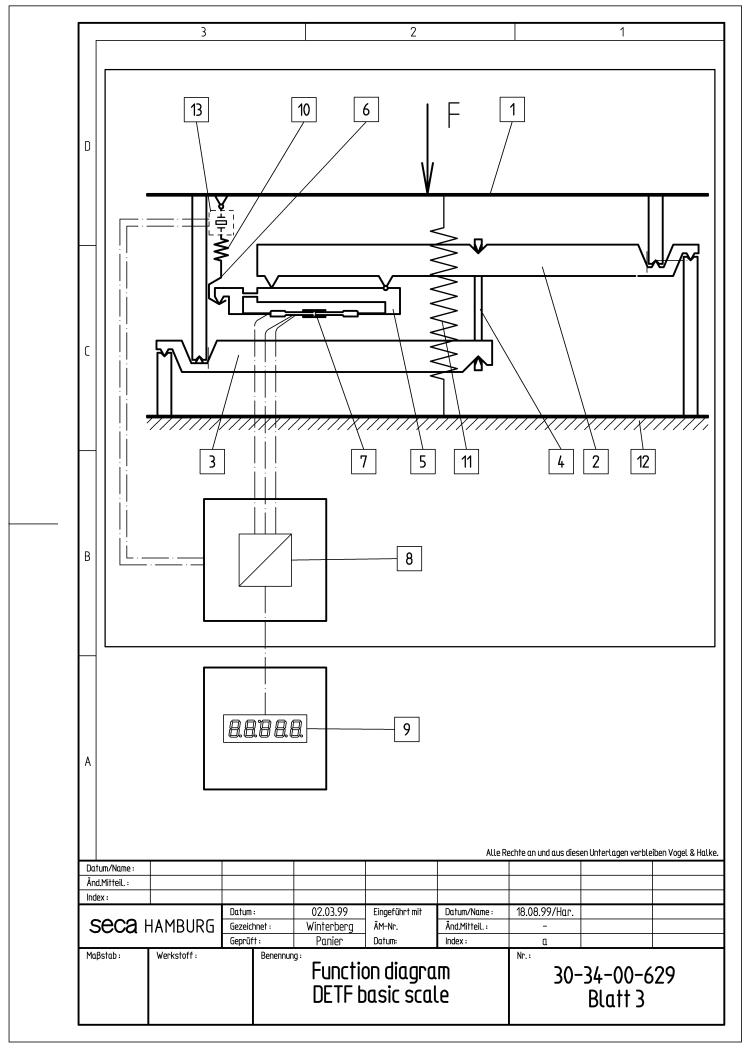Seca 766, 767 User Manual

Service Manual
Variants:
7661321009
7661321109
7661321139
7671321009
7671321004
for seca 766, 767
Service Manual Number
17-05-01-309-d
Valid as of: 02.12.2010
Description:
Electronic scale with DETF -module.
Mod. 766: Column scale, kg/lbs switch, body mass index, background iluminated display Mummy baby function.
Mod. 767: column scale, kg/lbs switch, body mass index
Content:
Function description |
30-34-00-629 a |
|
Description DETF modul |
30-34-00-617 |
|
Description Display modul |
30-34-00-618 a |
|
Description of Faults |
30-34-00-588 c |
|
Description of Calibration (lin.) |
30-34-00-603 |
|
PC configuration program |
30-34-00-672 b |
|
Replacement |
30-34-00-697 |
|
Spare parts |
30-34-00-698 |
d |
Manual number: 17-05-01-309-d

Service Manual
Functional description
Functional description DETF basic scale
Introduction
The DETF basic scale is a mechanical basic module for various seca scales. It is used for the electronic determination of the weight of adults. For the electronic measurement of the mechanical quantitiy “force” a double-ended tuning fork sensor (DETF) is used.
The above principle of operation has been realized on the one hand with a knife-edged load lever system to meet higher accuracy requirements and on the other hand with a more cost effective bearing-determined load lever system to meet slightly lower requirements.
Weighing
When a load is placed on the scale, the force due to gravity is transferred from the platform (1) to the load lever system.
The long load lever (2) transmits the force via the bending element (5) on to the hook (6). The force is reduced in accordance with the transmission ratio of the load lever. The force applied to the short load lever (3) is added to the force on the long load lever via the centre suspension (4).
A bending load acts on the bending element that increases the tensile force acting on the pretensioned tuning-fork sensor (7). This increases its resonant frequency in a non-linear way, which is measured by the connected electronics (8) and converted into a weight using the stored characteristic curve. The weight is output on the digital display (9).
together, but also exert an initial load which is necessary to reduce the hysteresis.
In the bearing-determined load lever system two springs exert a force which corresponds to a preload of approx. 15 kg.
In the knifed-edged load lever system 4 springs exert a force which corresponds to a preload of approx. 11 kg. The platform is prevented from being lifted by an additional locking device onto which the long load lever hits if the platform starts to rise (not for flat scales).
Vibration-sensitive switch (optional)
Any force exerted on the platform acts via load lever system, hook and overload protection device on the vibration-sensitive swich (13) which is fitted between overload protection device and platform. The load causes the vibration-sensitive switch to generate an electrical pulse which starts the connected electronics.
Overload protection device
The force acting on the hook is transferred to the overload protection device (10). This device is pressed against the platform by a pretensioned spring. If the load on the scale exceeds a permitted value, the spring yields and the load lever system is lowered.
Platform locking device
The platform retaining springs (11) do not only hold platform, frame (12) and load lever system
18.08.99 Har. |
30-34-00-629A |



Brief description of the DETF module
Introduction
The DETF module belongs to the family of seca electronic modules and is used to determine weight by means of a tuning-fork sensor system. The weight obtained is displayed on a separate display module. To allow the module to be adapted to different scales, an EEPROM is integrated with which it can be configured. A connection to the SeSAM bus (Seca’s Serial Autoconfiguring Multicontroller bus) is provided via which the scale can be calibrated and additional modules can be connected.
The following block diagram shows the most important function blocks of the force sensor and the DETF module:
Sensor |
|
EEPROM |
Bandpass |
|
|
|
|
|
|
filter |
Quartz |
Temperature |
µC |
SeSAM bus |
measurement |
|
|
|
|
Voltage measurement
Power on reset
Voltage
control
Battery/mains
connection
Weight measurement
A tuning-fork sensor screwed to a bending element is used as the weight sensor. If the scale is loaded, the bending element exerts a tensile force on the tuning-fork sensor, thus increasing its resonant frequency. By means of the bandpass filter the sensor is set vibrating at this frequency which is then measured by the microcontroller.
Using the value obtained and the individual calibration data stored in the EEPROM the controller calculates the weight.
The first value obtained after switch-on is used as the zeropoint. If the values obtained later on do not deviate strongly from this value, the zeropoint is corrected in order to compensate for possible drifts.
When the sensor is connected, care must be taken that the wires are not twisted to prevent crosstalk from the output to the input.
Temperature measurement
As the value measured by the tuning-fork sensor is affected by temperature, the temperature is measured regularly and compensated for accordingly.
Power supply
Power supply is provided by four AA size batteries and / or a seca mains transformer / desktop mains unit. From the power supply the voltage is passed via a reverse voltage protection diode to an in-phase regulator which provides a stabilized 3V supply voltage.
30-34-00-617 |
1 |
15.11.00 |
|
|
EE/Jensen |
In order to avoid measuring errors due to almost flat batteries, their voltage is measured at regular intervals. If the voltage drops below a certain limit, the user is alerted by the battery symbol in the LCD. If the next threshold is undershot, „bAtt“ is displayed and weighing is no longer possible.
In order to extend the on-time when the scale is mains operated, the microcontroller receives a signal when a mains transformer is connected.
It is possible to use rechargeable batteries, but the batteries will not be charged in the scale.
EEPROM
The DETF module accommodates an EEPROM on which all parameters are stored that can be used to influence the program sequence, for example various limit values or the coefficients for determining the weight and for temperature compensation.
Furthermore, the scale can store values to be retrieved when the scale is switched on the next time, e.g. the modules last connected.
Serial bus
To allow the scale to be calibrated and additional modules, such as displays, to be connected, the DETF module is equipped with an interface to the SeSAM bus.
On this bus the stabilized and non-stablized supply voltages are available. Via a data and a clock pulse line all relevant data is transmitted to other modules. A special start line is provided via which the scale can be switched on or other modules can signal that they want to send data.
Fault handling
If faults occur, the SeSAM bus initiates a fault message with the relevant fault code. Furthermore, each fault message includes the number of the module type on which the fault has occurred and a code which indicates how long the message is to stay on display and which displays are to be suppressed.
The fault messages are transferred to the SeSAM bus and can be output by the display module (module type for the DETF module = 1).
The following fault messages are implemented:
10 |
20 bit counter overflow |
|
|
11 |
Counts outside the permissible range |
|
|
12 |
Switch-on zeropoint outside the permissible range |
|
|
13 |
Zero follow-up outside the permissible range |
|
|
14 |
Fault in the kg value calculation |
|
|
15 |
Recalibration fault |
|
|
20 |
Battery voltage too low |
|
|
21 |
Fault in battery voltage measurement |
|
|
22 |
Fault in temperature measurement |
|
|
23 |
Temperature range exceeded ( < 0° C or > 50° C) |
30 |
General bus fault |
|
|
32 |
Command buffer full |
|
|
33 |
More than 8 slaves detected |
|
|
40 |
EEPROM fault |
|
|
41 |
Incorrect EEPROM access |
|
|
50 |
Other fault |
|
|
Instead of fault message 20 „bAtt“ is displayed and „temP“ instead of fault message 23.
Time base
From the quartz’s 4.19MHz a time base is derived which controls all timed processes in the scale. These are, for instance, various timeouts and the on-time.
30-34-00-617 |
2 |
15.11.00 |
|
|
EE/Jensen |
After expiry of the on-time, the supply voltage for the bandpass filter, for voltage measurement and for the EEPROM is switched off. All ports are set to zero-signal level and the quartz is stopped.
Recalibration
In order to compensate for linear measuring errors of the scale, which can, for instance, occur as a result of the different forces of gravity at different geographical points, the module has a recalibration function. Recalibration is performed via the SeSAM bus by means of a display module.
Technical data
Supply voltage: |
2.7V - 15V |
Supply current: |
typ. 0.9mA |
Quiescent current: |
typ. 2µA |
Operating temperature: |
approx. 0° C to 50° C |
Storage temperature: |
-10° C to 60° C |
Dimensions: |
56mm x 38mm x 20mm |
30-34-00-617 |
3 |
15.11.00 |
|
|
EE/Jensen |

Brief description of the display module
Introduction
The display modules belong to the family of seca electronic modules and are used to display a weight measured with a suitable module and transferred via the SeSAM bus (Seca’s Serial Autoconfiguring Multicontroller bus). Furthermore, the display modules accommodate the operating elements and can process the weight (hold, tare, etc.).
The following block diagram shows the most important function blocks of the display modules:
Display
The weight displayed on the LCD is updated approximately every 0.8s. A maximum of five digits as well as a few special characters can be displayed, which can appear as shown below:
Explanation of the special characters:
∙The battery symbol is used to alert of the fact that the battery is going flat.
∙The plug symbol indicates that the scale is operated on a mains transformer.
∙The warning triangle signals that the weight displayed on the scale is not verifiable.
∙Hold indicates that the weight display has frozen.
∙Tare or Net show that a weight on the scale has been tared out.
∙The left and right arrows point to additional explanations next to the display.
∙The weight units on the right show in which unit the measured weight is displayed.
30-34-00-618a |
1 |
25.07.06 |
|
|
QS / Eggers |

Power supply
Power supply is provided via the SeSAM bus.
Operation
With the exception of a start button that might be available, the connected buttons can be configured as required for the particular model. These buttons can be pressed just lightly or longer (longer than 1.5s).
If you press another button when switching on the scale, the scale will switch to the verification counter and recalibration mode.
SeSAM bus
The SeSAM bus connects the display modules to the other modules. On this bus the stabilized and non-stablized supply voltages are available. Via a data and a clock pulse line all relevant data is exchanged. A special start line is provided via which the scale can be switched on or the module can signal that it wants to send data.
Identification code
If several display modules are connected, an unmistakable ID code must be assigned to them using soldering jumpers to ensure that the different modules are correctly addressed via the bus.
Backlighting (optional)
Some display modules are equipped with a power supply for LCD backlighting. It can either be lit when the scale is switched on or only when the scale is loaded.
Signal transmitter (optional)
Some display modules are equipped with a signal transmitter. A piezo diaphragm is used which is controlled with a 4 kHz square-wave signal.
Clock module RTC (optional)
Display modules may be equipped with a clock function. If the circuit board is fitted with the relevant RTC components, when switching on the scale the time is indicated in the display for about 2 seconds. The power supply of the module results from the supply voltage of the scale. Voltage interruptions are compensated for a short time
Fault handling
If faults occur, the SeSAM bus initiates a fault message with the relevant fault code. Furthermore, each fault message includes the number of the module type on which the fault has occurred and a code which indicates how long the message is to stay on display and which displays are to be suppressed.
The display module displays its own fault messges on its LCD. Module type (for the display module = 3) and fault number are output. In addition, the fault messages that other modules have transferred to the SeSAM bus are displayed.
The following fault messages are implemented:
14Fault in the kg value calculation
15Recalibration fault
30 General bus fault
32Command buffer full
33More than 8 slaves detected
50Other fault
51Menu fault
Time base
From the quartz’s 4.19MHz a time base is derived which controls all timed processes in the scale. These are, for instance, various timeouts.
30-34-00-618a |
2 |
25.07.06 |
|
|
QS / Eggers |
